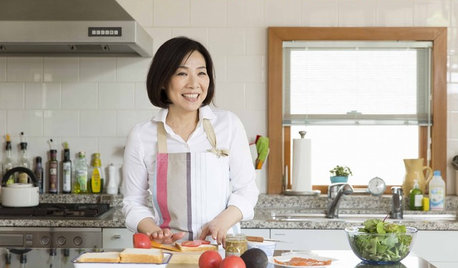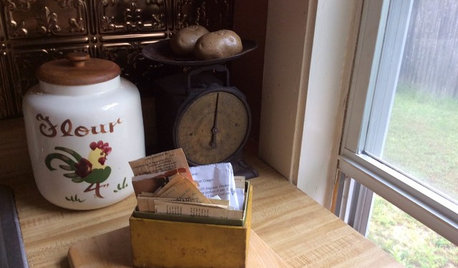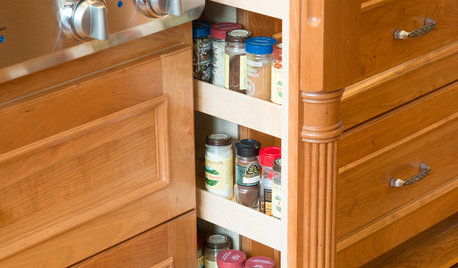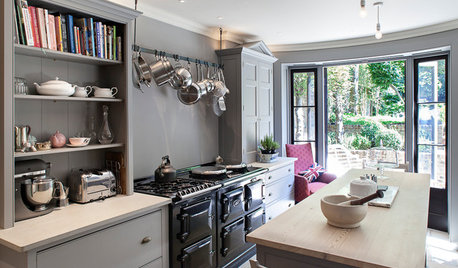Can I mess around with spices in pickle recipes?
This is another of my newbie pickler questions, trying to grasp the concept :).
Say I want to use a nchfp recipe like Baby Carrots or Quick Fresh Pack Dills. If the recipe calls for, say 2 tablespoons of mustard seed, can I substitute other kinds of spices, long as I don't go over about 2 tablespoons?
Or maybe not herbs, but seeds are ok, e.g. cumin seed, coriander? And less if ground seeds?
Can I sub other fresh herbs for fresh dill heads or dill weed? Can I sub onions for garlic? Bell pepper?
And is there any safe way to do up my own mix of vegies? For example, can I use the dilly bean recipe, but with other herbs and spices, and add some vegies that are not beans? Or maybe the carrots one since carrots are not very acidic and the recipe is almost all vinegar?
I want to be safe but I am not really a recipe person :).
Comments (26)
NilaJones
Original Author10 years agoI should clarify that I am talking about canning here, or low-temp pasteurization.
Also, can I use a meat thermometer for low-temp? Because that is what I have ;).
I am a bit confused about what changes do and don't matter for pickles, with all that vinegar.
Related Professionals
South Orange Landscape Architects & Landscape Designers · Estelle Landscape Contractors · Holland Landscape Contractors · Huntington Landscape Contractors · Kaneohe Landscape Contractors · Long Branch Landscape Contractors · Methuen Landscape Contractors · North Potomac Landscape Contractors · Spring Landscape Contractors · Golden Valley Landscape Contractors · Fruitville Roofing & Gutters · Minnetonka Roofing & Gutters · Fullerton Driveway Installation & Maintenance · La Vista Driveway Installation & Maintenance · Middle Island Driveway Installation & Maintenancedigdirt2
10 years agoAgree with Carol. Recipes are used in canning because of the science underlying it. Unlike cooking where experimentation is encouraged. Tread very carefully.
And also keep in mind that not all pickle recipes are the same when it comes to amount of vinegar. It is one thing to experiment with a straight vinegar brine recipe but quite another thing to experiment with one that calls for water-diluted vinegar as many do.
Dried spices, dried herbs, dried foods are fine to play with within reason but freah herbs and food additions are not.
I've never seen a meat thermometer that read all that accurately but if yours does then it will probably be ok. But please keep in mind that the guidelines limit the pasteurization processing to only certain recipes and notes that limitation in the instructions. It isn't applicable to any other recipes.
Dave
2ajsmama
10 years agoI'd stick to approved recipes (e.g., a carrot recipe for carrots, cucumber for cucumbers) until you are more experienced. As Dave said, you can change dried herbs and spices but not fresh - again, don't go crazy right now as you may find you don't like the taste. The Joy of Pickling has a lot of different (non-dill) recipes for different vegetables, so I suggest that as a starting point. Some recipes are for fermenting, others are quick (vinegar) pickles, some can be canned, either BWB or low-temp pastuerization and some are only for refrigerator.
You would use less seed, even less ground since they are stronger than you would of a fresh herb like dill. But ground spices can make a brine murky.
What vegetables are you thinking of pickling?
Linda_Lou
10 years agoThere are some mixed pickle recipes available for use.
Here is just one recipe for you.Here is a link that might be useful: Mixed pickled vegetable recipe.
digdirt2
10 years agoIt dawned on me we are focusing on your desire to experiment rather than answering your specific questions.
If the recipe calls for, say 2 tablespoons of mustard seed, can I substitute other kinds of spices, long as I don't go over about 2 tablespoons? Yes, keeping in mind that they must be dry and the resulting taste is unknown and may either intensify or fade.
Or maybe not herbs, but seeds are ok, e.g. cumin seed, coriander? And less if ground seeds? Yes. Ground I avoid because as Sheila said - murkey brine and ugly appearance.
Can I sub other fresh herbs for fresh dill heads or dill weed? Most likely no, pH will be affected.
Can I sub onions for garlic? Bell pepper? No, very different pH. General rule is you can sub like for like ie. hot peppers for sweet peppers and red onions for yellow onions, etc. Beyond that the pH of the particular vegetable comes into play and can affect the rest of the recipe safety.
And is there any safe way to do up my own mix of vegies? Yes, there are recipes available for mixed pickled vegetables. They are called "Giardiniera" (aka Jardiniere). But no, it isn't safe to use a recipe for carrots to do mixed vegetables.
Pickled mixed vegetables - http://nchfp.uga.edu/how/can_06/pickled_mixed_veg.html
There is also one in the BBB called Jardiniere (p. 86) and some in Joy of Pickling book too.
Hope this helps.
Dave
NilaJones
Original Author10 years agoThank you, folks!
So, is there no safe way to use fresh herbs other than dill, in pickling? (Except maybe in freezer pickles? But I am OUT of freezer space.)
You folks asked what vegies I want to use. Well, what I want to do is use whatever is ready to be picked on the day, or sitting in the fridge :). Lately that is mainly cukes and green beans, with additions of onions, bell pepper, baby carrots, maybe some parsnips or tomatoes, for flavor and visual appeal.
I am not growing any cauliflower, which all the 'mixed veg' recipes seem to call for. Can I just leave it out because it is relatively alkaline? Sub parsnips?
What I would love to do is pick what is ripe on the day, put it in jars with fresh and dried herbs and spices that I think would go well, add an appropriate brine, and can or pasteurize. Even with 100% vinegar, no water, is this never safe? Am I dreaming?
Also, is there any way I can have some of the vinegar be homemade wine vinegar of unknown acidity? Is that safe if I refrigerate and eat within two weeks? Or if I sub it for water (but never for vinegar) in a canning recipe? I have all this wine that went to vinegar...
I am relieved that it sounds like at least I can do what I want with dried spices :).
digdirt2
10 years agoLike I said above, " It is one thing to experiment with a straight vinegar brine recipe but quite another thing to experiment with one that calls for water-diluted vinegar as many do."
With 100% vinegar that is 5% acidity you can do just about anything within reason, even fresh herbs, if you fully process it in a BWB.
Where it becomes an issue is with the water diluted brine recipes. And pasteurization rather than processing wouldn't be recommended. Not to mention the texture of the end product would be better with processing rather than pasteurization.
Keep in mind that pasteurization is only a limited use recommendation. It says: Caution: Use only when recipe indicates. and it presumes refrigeration afterward, not shelf storage. BWB processing and pasteurization aren't interchangeable processes. Please don't think of them as equals.
Homemade wine vinegar of unknown acidity? The links provided make that very clear so no not unless you want to just ignore the guidelines. And using it instead of water to dilute the 5% vinegar called for is just that - diluting the vinegar to less than 5%.
Well, what I want to do is use whatever is ready to be picked on the day, or sitting in the fridge :). Lately that is mainly cukes and green beans, with additions of onions, bell pepper, baby carrots, maybe some parsnips or tomatoes, for flavor and visual appeal.
I am not growing any cauliflower, which all the 'mixed veg' recipes seem to call for. Can I just leave it out because it is relatively alkaline? Sub parsnips?
Sure you can leave out the cauliflower. You can always just leave out any low acid ingredient as long as you understand it will change the end volume and flavor. But the pH will still be fine - better even.
But substituting is a whole other ball game as I said above. You have to know the pH. Cauliflower is 5.65, parsnips 5.30-5.70 so IMO an ok sub in this particular case if amount kept the same.
Unfortunately canning safety doesn't always allow us room to do what "we want to do", especially when it comes to mixing things. This is because its basic underlying philosophy is safety not convenience. It knows we can make all these mixed things AFTER we open the jars so canning focuses on preserving the basics so they can be used all mixed together in the off season. It's a safety limitation we all have to work within. :)
Dave
Here is a link that might be useful: USDA Food pH list
NilaJones
Original Author10 years agoI found a copy of Joy of Pickling at my neighborhood store, and I'm all excited about it :). Thanks for the recc!
And thank you, Dave and Carol and ajsmama and lindalou, for taking the time to explain stuff to me :).
I DO care, a lot, about safety. That Is why I am asking questions. I only phrased that as 'What I want to do' because people were asking the question that way. If I wanted to just do my own thing regardless of safety I wouldn't be here :).
>With 100% vinegar that is 5% acidity you can do just about anything within reason, even fresh herbs, if you fully process it in a BWB.
Ok.
>Keep in mind that pasteurization...presumes refrigeration afterward, not shelf storage.
Ooo, I missed that! I am glad I asked :(.
>Homemade wine vinegar of unknown acidity...using it instead of water to dilute the 5% vinegar called for is just that - diluting the vinegar to less than 5%.
I don't think we are talking about the same thing. Here's what I mean: A tested recipe calls for 1 part cider vinegar and 1 part water. If I sub 1 part cider vinegar and 1/2 part water and 1/2 part wine vinegar -- I am making the resulting brine MORE acidic, not less. So, is that ok?
Thanks for the pH list!!
readinglady
10 years agoSure, using vinegar of any sort in lieu of water is going to increase acidity.
I love parsnips but I'm trying to wrap my head around them pickled.
Carol
digdirt2
10 years agoA tested recipe calls for 1 part cider vinegar and 1 part water. If I sub 1 part cider vinegar and 1/2 part water and 1/2 part wine vinegar -- I am making the resulting brine MORE acidic, not less. So, is that ok?
Ahh, sorry I misunderstood that part. 'nother one of those darn senior moments.
Dave
2ajsmama
10 years agoThere are a number of recipes in Joy of Pickling that can be pastuerized - Linda Z does not say that they must then be refrigerated so I assumed it was an alternative to BWB (only certain recipes, and the temperature is critical - must be over 180 but less than 185).
Then again, I have an older version of the book. We have eaten some dills that were pastuerized last year, still have 5 jars left. I used a candy thermometer and boy was it tough to keep it in that 5-degree range on a glass top stove (with the thermometer glass fogging up and me burning my arm with the steam). I won't try it again, but do I need to throw out the pickles?
readinglady
10 years agoI see no reason to discard the pickles. I always understood pasteurization was suitable for shelf storage (when used for approved recipes) but you could always email Linda Ziedrich for clarification.
I've low-temp pasteurized pickles but mainly found it a pain and (to me) not really that much different from standard processing.
Carol
2ajsmama
10 years agoThanks Carol - I just doublechecked NCHFP and they don't say refrigerator storage. Maybe because they were slices, they still got soft (I put Pickle Crisp in them too - the only batch I did with PC, and now that jar is expiring, did you know calcium chloride expired? I've been trying to remember to use it every batch this year).
2ajsmama
10 years agoOh, Nila - Joy of P has recipes using tarragon and bsail as I recall for fresh herbs but be careful with basil - it gets bitter, I had to throw out my last jar of Ellie Topp's Chunky Basil Pasta Sauce b/c it tasted too strong. I don't recall if there are any pickle recipes using cilantro (that's more for salsas, and b/c of pH not many salsa recipes include it, better to stir in fresh when you open it). Other than those herbs (and of course dill) I don't recall any others that are used. For example, while you can substitute dill weed or seed for dill heads, you can't sub mustard greens for mustard seed (big pH difference! and I'd think a difference in flavor), you could probably throw in coriander seed instead of cilantro (even when recipe didn't call for cilantro) but the taste will be slightly different. Lots of pickle recipes call for coriander seed - mostly the sweeter pickles. I like whole cloves and allspice too - just got some on sale (as well as cumin seed, which might not go as well in a sweet pickle but I picked it up to try some corn salsa sometime).
digdirt2
10 years agoSorry but IMO pasteurization, as a process of food preservation (of any food), presumes refrigerated, not shelf storage. It is inherent in the definition of the process and how it does and doesn't work. Can you think of any pasteurized food that is not refrigerated?
Pasteurization reduces the bacteria in a food but doesn't "sterilize" it or reach a temperature high enough to kill many bacteria. If you keep it at room temperature, its bacterial count will rise much more quickly than under refrigeration.
This is not UHT pastuerization we are talking about yet even it requires refrigeration.
Like Carol said I personally can't see why anyone would use the method simply because of the negative effects it has on the food not to mention how difficult and time consuming it is (and yes I have tried it). But it is your choice as long as it is limited to the recipes for which it has been approved as NCHFP says.
Dave
readinglady
10 years agoFrom University of Maine Extension but also on other Extension sites:
Check lid seals. If the center of the lid is indented, the jar is sealed. Wash, dry, label, and store sealed jars in a clean, cool, dark place. . . . Pickles are best if used within a year and safe as long as lids remain vacuum sealed.
So shelf storage as long as the recipe indicates.
Carol
readinglady
10 years agoIt's general instructions for pickle processing including both BWB and pasteurization for those recipes which specify it. The instructions were posted by U Maine Extension but they credit Penn State and USDA.
There is an added precaution that spoilage is more likely if pasteurization is not managed properly.
But yes, pasteurized pickles can be shelf-stored with the caveat that the entire process is more meticulous and less reliable.
Carol
seysonn
10 years agoSo, is there no safe way to use fresh herbs other than dill, in pickling?
******************************************************definitely NOT so. It depends on what flavor/taste you like. For example, you can use mint. I use a lot of lemongrass, sometimes lemon balm. These stuff do not have a lot of moisture contents to dilute the preservative effect of the brine.That is the key.
fotophreek
10 years agoI hope adding my question to this link makes sense. I want to use a mixed vegetable pickle recipe such as Ball's Jardiniere. I know from lurking here that you can omit non-acid ingredients from a recipe and still be safe (ie mushrooms from a spaghetti sauce recipe). My problem is my kids will only eat the carrots and cauliflower out of the jars. If I make the recipe leaving out the garlic, celery, onions, zucchini, and peppers, I have a ton of pickling liquid left over. Will this be safe to can more carrots and cauliflower with? I know different foods have different pH and I am eliminating a heck of a lot of veggies but this 4c vinegar to 2 c water seems the same as the acid ratio 2/1 safety margin quoted (from Colorado Ext mixed veg pickle recipe mentioned by Linda Lou above). I was thinking of doing 5 c vinrgar to 2 cups water to be safer. Sorry, I have picky kids.
This post was edited by fotophreek on Sun, Jan 5, 14 at 16:54
fotophreek
10 years agoSorry, i edited the above msg a few times due to trying to do 2 things at once and in a hurry.
digdirt2
10 years agofotophreek - Since you won't be making a jardiniere then you shouldn't use the jardiniere instructions as it is balanced just for those vegetables and as a general rule you cannot sub different vegetables for each other.
Instead instructions are available for both pickled carrots and for pickled cauliflower at NCHFP and in the books so why not just make them? Use either set of additional ingredients you prefer but note the processing time is longer for carrots than for cauliflower so use the carrot time if you choose to combine them in the same jar.
As for the vinegar to water, the recommendation for the carrots is 5.5:1 and the cauliflower recipe calls for 4:0.
Dave
Here is a link that might be useful: NCHFP - Pickled carrots and cauliflower
fotophreek
10 years agoMy kids just don't like the taste of the pickled carrots recipe and the pickled cauliflower recipe. Could I take the cauliflower recipe (4/0), sub half carrots (lower pH ingredient vs. cauliflower) and add more sugar (how much)? I really hate to add more sugar to our diets, though.
So, what are the limits of taking out low-acid ingredients (any rule such a 10% of total mix? Can spices be eliminated too)? NCHFP says eliminating mushrooms in the Spagh. sauce is ok. Why is this so? For instance.....
I am assuming it would be safe to take the Colorado ext. recipe and eliminate the garlic (garlic is an issue for a lot of my family)? It says "as desired" after the garlic, so I would think adding none would be ok, but then doesn't that change the pH balance of the vegetable mix (Dave as you stated above)? I don't understand the safety margins when it comes to things like this. Are they calculating a margin of safety so eliminating a cup of low-acid ingredients is ok.... or did they test both recipe versions (garlic vs. no garlic) and found them both safe?
Does anyone have an approved recipe for mixed pickled vegetables with carrots, cauliflower, onion, cukes or preferably zukes (or both)? Some sweet pepper is ok too, but my husband and I get sick of being left with so many peppers after the kids open a jar so I wasn't thinking the Colorado recipe would be the ultimate answer even if I could eliminate the garlic. But maybe that is what I am stuck with.
I was also wondering if I pressure canned the cauliflower/carrot pickle mix if It would make it safe. Normally I would be concerned it would make the veggies too mushy. But, we don't mind the texture when we pressure can carrots (unpickled) according to Ball directions. I figure the cauliflower couldn't get any more mushy than what the carrots get. As long as my kids eat them and they are safe, texture can slide. Any thoughts? Add picklecrisp? Would the same processing times for pressure canning carrots (25 min pints) work (especially since it would be in an acidic solution)? Ok, maybe I'm crazy but I have to ask.
THX!!!!
malna
10 years agoI would use Linda Z.'s Jardiniere recipe from the Joy of Pickling. She notes "you needn't stick with the vegetables here; alternative ingredients might include cauliflower florets, onion chunks, green beans in 2-inch lengths, zucchini in sticks or thick rounds, and celery pieces. You'll need 5 pints of prepared vegetables."
I use this recipe a lot when I have a "little of this and a few of those" vegetables. I interpret her note to mean as long as you have 5 pints of vegetables, the proportions are up to you.
Jardiniere
Source: Joy of Pickling1-1/4 pounds 1- to 3-inch pickling cucumbers, washed with blossom end removed
2 medium red bell peppers, cut into squares or strips
1/2 pound shallots, peeled (I grow shallots and they are wonderful in this recipe)
1/4 pound carrots, cut into thin sticks
1/2 pound 1-inch wide patty pan squashes, or slightly larger ones halved
5 large garlic cloves
1-1/4 teaspoons black peppercorns
20 allspice berries (I reduce or leave these out)
5 tarragon sprigs
5 thyme sprigs
5 small fresh chile peppers (optional)
2-3/4 cups white wine vinegar (mine is 7% acidity)
2 cups water
1 tablespoon pickling saltPut one garlic clove, 1/4 teaspoon peppercorns and 4 allspice berries in each of 5 pint canning jars. Pack jars with vegetables. Add a tarragon sprig and thyme sprig, and a chile pepper if you like, then shake jars to settle the vegetables.
Bring to a boil the vinegar, water and salt, stirring to dissolve the salt. Pour hot liquid over the vegetables, leaving 1/2 inch headspace. Close with lid and ring, and BWB for 20 minutes.
Store at least 3 weeks before eating (they are MUCH better after they sit).
















readinglady